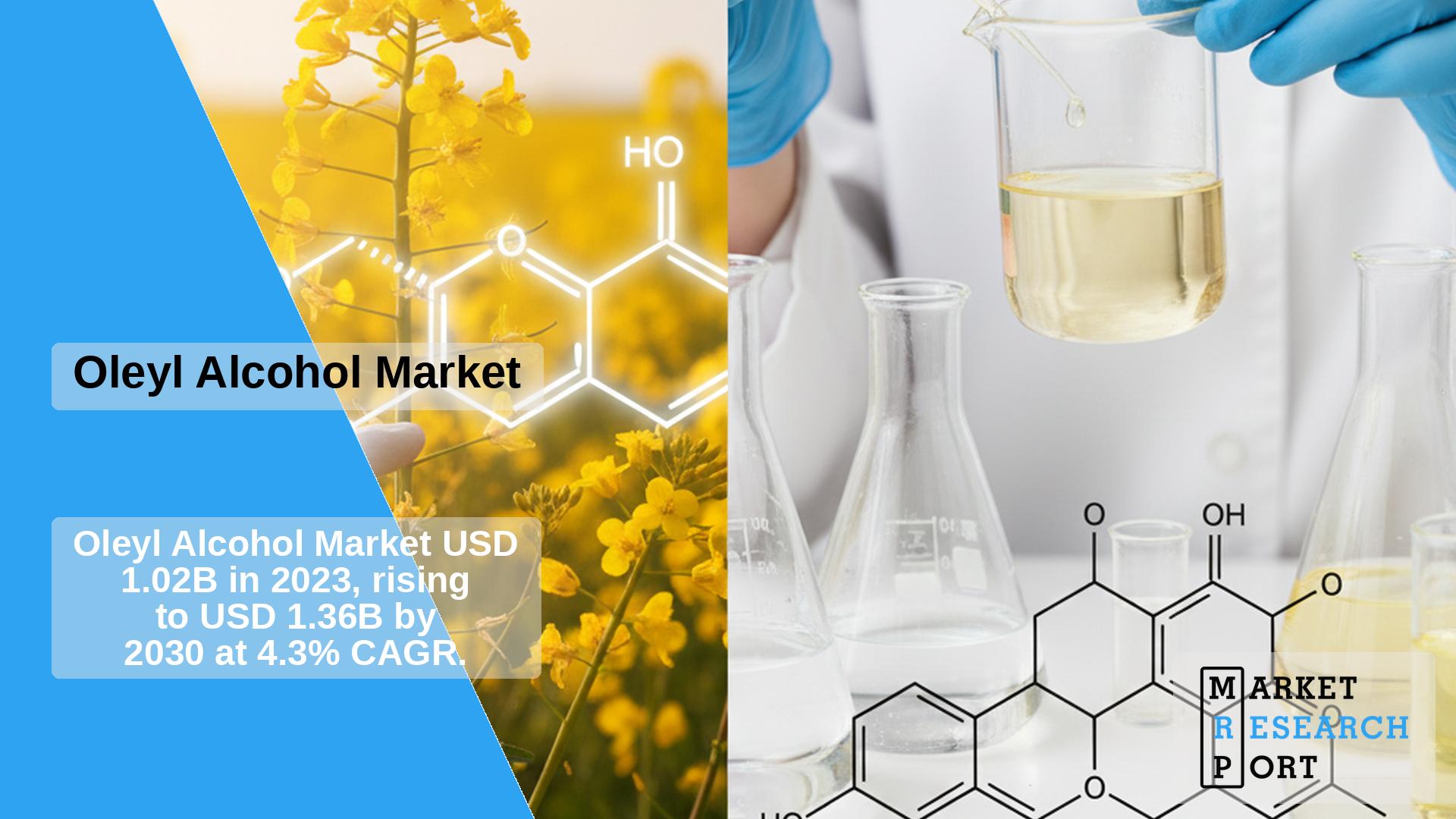
The global oleyl alcohol market was valued at approximately USD 1.02 billion in 2023 and is projected to reach USD 1.36 billion by 2030, growing at a compound annual growth rate (CAGR) of 4.3% between 2024 and 2030. This market growth is driven by the product’s eco-friendly nature, high purity, and superior performance characteristics.
Oleyl alcohol, a clear liquid with a distinctive odor, is derived from natural sources such as soybean, castor, palm kernel, and rapeseed oils, as well as fish oil and other aquatic animal oils. It is also synthesized chemically from propylene glycols and ethylene. Production typically involves catalytic hydrogenation of oleic acid esters or a Boweault-Blanc reduction process using butyl oleate. The product finds extensive use as a defoaming agent, plasticizer, rheology modifier, chemical intermediate, cosmetic emollient, and automotive lubricant.
The expanding use of oleyl alcohol in pharmaceutical R&D, particularly for drug delivery applications, presents promising growth prospects. However, fluctuating raw material costs pose challenges to manufacturers. Growing development of cost-effective, bio-based surfactants involving oleyl alcohol by leading producers is expected to support demand.
Oleyl alcohol distribution occurs either directly to large-volume buyers, including manufacturers in cosmetics, food & beverage, and cleaning products, or via third-party distributors serving smaller customers.
The oleyl alcohol market is moderately competitive, with key participants investing in research and innovation. Leading producers include Ecogreen Oleochemicals, Croda International, Stepan Company, Sasol, and Lubrizol Corporation, among others.
Demand is increasing for bio-based oleyl alcohol derived from renewable sources like vegetable oils, driven by consumer preference for green and biodegradable products, particularly in cosmetics and cleaning applications.
The fish oil segment led the market with a 31.3% revenue share in 2023. Key benefits such as cardiovascular support and omega-3 fatty acid content stimulate its demand. Olive oil-derived oleyl alcohol is also gaining traction due to health benefits recognized in food and beverage industries.
Personal care and cosmetics applications dominated in 2023 due to rising consumer awareness of personal hygiene and demand for anti-aging products. Oleyl alcohol is commonly used in formulations such as creams, conditioners, lipsticks, and other cosmetics, valued for its moisturizing and emollient properties.
The surfactants segment is the fastest growing, as oleyl alcohol forms a precursor for wetting agents in detergents used in laundry, dishwashing, and surface care products, fostering growing demand.
Additionally, oleyl alcohol serves as a softener and lubricant in textile processing and is used in medical drug delivery formulations targeting transdermal and mucosal administration.
North America is expected to experience strong growth, driven by large end-use industries such as personal care, food & beverages, and textiles. Regulatory approvals by organizations like FDA and CIR support product acceptance.
The U.S. market is propelled by rising environmental awareness, increasing demand for bio-based surfactants, and growing applications in personal care and pharmaceutical industries.
Asia Pacific led the global market share, driven by stringent regulations and growing consumer preference for bio-based products, especially in countries like China, India, and Japan.
Prominent players include Croda International, BASF, Lubrizol Corporation, Ecogreen Oleochemicals, Acme Synthetic Chemicals, and ATAMAN KIMYA.
| Report Attribute | Details |
|---|---|
| Market size in 2024 | USD 1.05 billion |
| Revenue forecast in 2030 | USD 1.36 billion |
| Growth rate (CAGR) | 4.3% (2024–2030) |
| Base year | 2023 |
| Historical data | 2018–2022 |
| Forecast period | 2024–2030 |
| Quantitative units | Revenue (USD billion) |
| Report coverage | Revenue forecast, company ranking, competitive landscape, growth factors, trends |
| Segments covered | Source, application, region |
| Regional scope | North America, Europe, Asia Pacific, Latin America, Middle East & Africa |
| Country scope | U.S., Canada, Mexico, Germany, UK, France, Italy, Spain, Netherlands, Russia, Switzerland, Poland, Sweden, China, Japan, India, South Korea, Australia, Malaysia, Singapore, Indonesia, Taiwan, Brazil, Argentina, Saudi Arabia, South Africa, UAE |
| Key companies profiled | PT. Ecogreen Oleochemicals, Croda International, The Lubrizol Corporation, Acme Synthetic Chemicals, SimSon Pharma, ATAMAN KIMYA, Zhengzhou Alfa Chemical, BASF SE, Tokyo Chemical Industries |
The report forecasts revenue and volume growth globally, regionally, and by country, analyzing recent industry trends (2018–2030) segmented by source, application, and region.